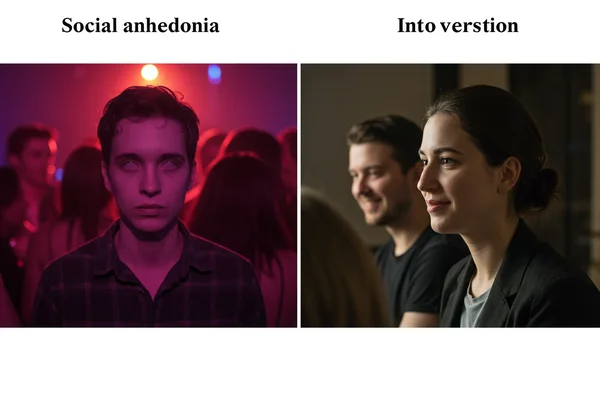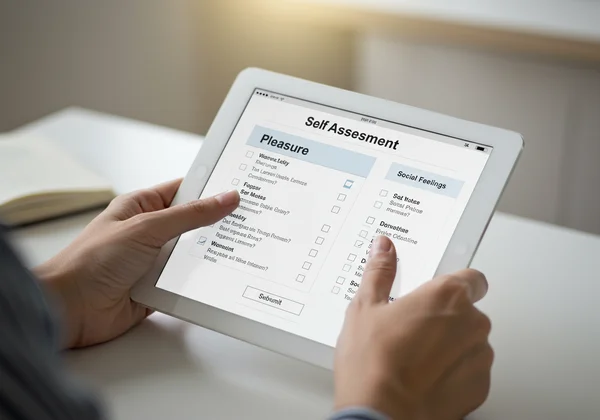Anhédonie sociale vs. Introversion : Comprendre les symptômes et faire un test d'anhédonie
Le sentiment de déconnexion dans les situations sociales peut être déroutant. Vous pourriez vous retrouver à refuser des invitations ou à vous sentir émotionnellement distant lors de conversations, vous amenant à vous interroger sur la raison. Est-ce simplement une partie de votre personnalité, comme être introverti ? Ou pourrait-ce être le signe de quelque chose de plus, comme l'anhédonie sociale ? Suis-je plutôt introverti(e) ou atteint(e) d'anhédonie sociale ? Si cette question résonne en vous, comprendre la distinction est une étape clé pour mieux vous comprendre et vous sentir plus à l'aise. Cet article vous aidera à différencier ces deux expériences et vous guidera sur le moment où il pourrait être utile de faire un test d'anhédonie gratuit pour obtenir un aperçu plus approfondi.
Comprendre l'anhédonie sociale
L'anhédonie sociale n'est pas à proprement parler un trait de personnalité ; il s'agit plutôt d'un terme clinique qui décrit une capacité réduite à ressentir du plaisir lors des interactions sociales. Bien que de nombreuses personnes associent l'anhédonie à la dépression, elle peut exister seule ou comme symptôme d'autres affections. C'est plus qu'une simple préférence pour la solitude ; c'est un déficit notable de la joie, de la connexion et de la récompense que la plupart des gens retirent des interactions sociales. Obtenir une compréhension de base peut être une première étape cruciale, et un test d'anhédonie sociale confidentiel peut fournir des informations précieuses.

Qu'est-ce que l'anhédonie sociale ?
À la base, la perte du plaisir social est la caractéristique définissante de l'anhédonie sociale. Elle fait référence à un désintérêt marqué pour les contacts interpersonnels et à une capacité diminuée à ressentir des émotions positives lors des activités sociales. Une personne qui en souffre peut trouver que des activités qu'elle appréciait autrefois avec des amis, comme partager un repas, célébrer un anniversaire ou même avoir une simple conversation, lui semblent désormais fades, peu gratifiantes ou comme une corvée. Il ne s'agit pas de timidité ou d'anxiété sociale, qui découlent de la peur du jugement ; ici, c'est l'absence de plaisir elle-même qui est en jeu.
Symptômes clés de l'anhédonie sociale
Reconnaître les signes est essentiel pour comprendre ce que vous pourriez vivre. Les symptômes de l'anhédonie dans un contexte social vont souvent au-delà de la simple évitement. Ils incluent :
- Paraître distant sur le plan émotionnel dans les conversations.
- Avoir peu ou pas d'amis proches en raison d'un manque d'intérêt à nouer des liens.
- Ne pas rechercher d'opportunités sociales parce qu'elles n'offrent aucune récompense.
- Trouver difficile de ressentir des émotions positives comme la joie ou l'affection pour les autres.
- Préférer être seul non pas pour se ressourcer, mais parce que l'interaction sociale semble vide.
Si ces signes vous sont familiers, les explorer davantage par une auto-évaluation peut être un moyen proactif d'en apprendre davantage.
L'expérience de la perte de plaisir social
Imaginez que vous êtes à une fête surprise pour un ami proche. Tout le monde rit, partage des histoires et célèbre. Un introverti pourrait se sentir surstimulé après un certain temps, mais ressentirait toujours un bonheur sincère pour son ami. Une personne atteinte d'anhédonie sociale, cependant, pourrait se sentir détachée de toute la scène. Elle voit la joie mais ne la ressent pas intérieurement. L'expérience est vide, créant un profond sentiment d'isolement même lorsque la personne est entourée de monde. Cet engourdissement émotionnel est une caractéristique de la condition et une raison principale pour laquelle les gens cherchent des réponses.
Explorer l'introversion : un trait de personnalité
Il est vital de distinguer l'anhédonie sociale de l'introversion, un trait de personnalité parfaitement sain et courant. Mal comprendre l'introversion peut entraîner des inquiétudes inutiles, tandis que ne pas reconnaître l'anhédonie peut empêcher quelqu'un de chercher le soutien dont il a besoin.

Que signifie être introverti ?
L'introversion concerne la gestion de l'énergie. Les introvertis tirent de l'énergie du temps passé seuls et dépensent de l'énergie dans les situations sociales. Cela ne signifie pas qu'ils n'aiment pas les gens ou les événements sociaux. En fait, de nombreux introvertis ont des relations profondes et significatives et aiment socialiser, mais ils le font d'une manière différente des extravertis. Ils préfèrent souvent les petits groupes, les conversations en tête-à-tête et ont besoin de temps calme pour recharger leurs réserves d'énergie sociale par la suite. Un introverti pourrait adorer aller à un concert mais avoir besoin du lendemain pour récupérer.
L'introversion : une préférence, et non un problème
Contrairement à l'anhédonie sociale, qui implique un déficit de plaisir, l'introversion est une question de préférence. Un introverti choisit la solitude pour se sentir au mieux, mais il est tout à fait capable de ressentir de la joie, de la connexion et de l'excitation dans des contextes sociaux qui correspondent à sa nature. Il ne manque pas de capacité de plaisir social ; il le consomme simplement différemment et en différentes quantités. C'est une partie stable de son identité, pas un symptôme pénible qui est apparu et a perturbé sa vie. Comprendre cela peut vous aider à décider si un quiz gratuit sur l'anhédonie pourrait être pertinent pour vous.
Anhédonie sociale vs. Introversion : distinctions clés
Bien que les deux puissent conduire à passer plus de temps seul, les raisons sous-jacentes et les expériences internes sont très différentes. Voici un aperçu des distinctions clés qui peuvent vous aider à déterminer si vous devriez envisager de faire un test d'anhédonie.

La motivation derrière le retrait social
C'est peut-être la différence la plus révélatrice.
- Un introverti se retire pour se ressourcer : Un introverti refuse un troisième événement social de la semaine car il se sent à court d'énergie. Il fait un choix conscient pour préserver son bien-être afin de pouvoir s'engager sincèrement plus tard. Sa motivation est réparatrice.
- Une personne atteinte d'anhédonie sociale se retire en raison d'un sentiment de vide : Quelqu'un atteint d'anhédonie sociale se retire parce que l'événement ne promet aucun plaisir. La motivation est l'évitement d'une expérience non gratifiante et vide. Il ne s'agit pas d'énergie ; il s'agit d'un manque de récompense anticipée.
Réponse émotionnelle à l'interaction sociale
Le sentiment interne pendant et après les événements sociaux est un autre indice crucial.
- Un introverti ressent une connexion : Un introverti peut ressentir une joie profonde, de la chaleur et une connexion lors d'une conversation significative avec un ami, même si cela le fatigue. L'émotion positive est présente et source de satisfaction.
- Une personne anhédonique se sent engourdie : Quelqu'un atteint d'anhédonie sociale ressent une platitude envahissante. Même avec des êtres chers, l'interaction peut sembler superficielle et déconnectée parce que l'« étincelle » émotionnelle est absente. L'expérience n'est pas enregistrée comme plaisante. Si cela décrit votre expérience, une évaluation basée sur la science peut offrir de la clarté.
Impact sur le bien-être et le fonctionnement quotidien
Enfin, examinez comment vos habitudes sociales affectent votre qualité de vie globale.
- L'introversion est un trait stable : Être introverti est une partie constante de qui vous êtes. Cela ne cause généralement pas de détresse ; au contraire, le comprendre vous aide à structurer votre vie d'une manière qui vous apporte du contentement.
- L'anhédonie sociale est source de détresse : L'anhédonie sociale ressemble souvent à un changement significatif et négatif. Elle peut entraîner la solitude, nuire aux relations et être une source de confusion et de tristesse, impactant négativement votre bien-être mental. Cela donne le sentiment que quelque chose ne va pas ou fait défaut.
Quand envisager un test d'anhédonie
Si les descriptions de l'anhédonie sociale résonnent plus fortement avec votre expérience que celles de l'introversion, il est peut-être temps de chercher plus de clarté. Une auto-évaluation est un moyen entièrement confidentiel et sans pression d'explorer ces sentiments. Envisagez de faire un test d'anhédonie en ligne si vous vous identifiez aux éléments suivants :

Manque persistant de joie dans les contextes sociaux
Si vous ressentez constamment un manque de plaisir dans presque toutes les situations sociales, même celles que vous aimiez auparavant, c'est un indicateur important. Il ne s'agit pas d'avoir occasionnellement une mauvaise journée ; c'est un schéma persistant de ne pas tirer de joie de la compagnie d'autres personnes.
Changements significatifs dans le comportement ou l'intérêt social
Avez-vous remarqué un changement majeur ? Peut-être étiez-vous auparavant l'âme de la fête ou attendiez-vous toujours avec impatience les réunions hebdomadaires, mais vous ressentez maintenant une profonde indifférence à l'égard de tout cela. Ce changement par rapport à votre état antérieur est une bonne raison d'explorer ce qui se passe.
Se sentir émotionnellement engourdi ou en détresse en présence d'autrui
Si votre sentiment principal en présence d'autrui est l'engourdissement, le vide, ou même la détresse face à votre incapacité à vous connecter, c'est un signal clair que quelque chose de plus qu'une préférence de personnalité est en cause. Cette déconnexion émotionnelle est un signal qui mérite d'être exploré. Un test d'anhédonie anonyme peut être un point de départ sûr.
Rechercher la clarté : votre prochaine étape vers la compréhension
Distinguer l'anhédonie sociale de l'introversion, c'est comprendre la différence entre une préférence de personnalité et un symptôme potentiel qui affecte votre bien-être. L'introversion est une façon d'être, tandis que l'anhédonie sociale est une absence de plaisir. Reconnaître cette différence vous aide à décider de la meilleure prochaine étape.
Si vous vous interrogez sur vos expériences, vous n'êtes pas seul. Comprendre vos expériences est la première étape de tout cheminement vers une meilleure santé émotionnelle. Une excellente première étape est de faire le test d'anhédonie sur notre page d'accueil. Il est gratuit, entièrement anonyme et basé sur l'échelle de plaisir de Snaith-Hamilton (SHAPS) validée scientifiquement pour vous offrir un aperçu instantané et confidentiel de votre capacité à ressentir de la joie.
Foire aux questions sur l'anhédonie sociale et l'introversion
Quels sont les symptômes clés de l'anhédonie sociale ?
Les symptômes clés de l'anhédonie sociale incluent un intérêt réduit pour le contact social, trouver peu ou pas de plaisir dans les interactions, avoir peu de relations proches en raison d'un désintérêt, et paraître émotionnellement plat ou retiré en présence d'autrui. Il s'agit d'un manque de gratification ou de récompense lié aux activités sociales, et non d'une peur de celles-ci.
Comment tester l'anhédonie si je pense en souffrir ?
Un excellent point de départ est un outil d'auto-évaluation éprouvé. Par exemple, le test gratuit en ligne que nous proposons est un outil de dépistage confidentiel basé sur des échelles psychologiques établies comme la SHAPS. Il fournit des résultats immédiats pour vous aider à mieux comprendre vos sentiments, servant de ressource utile à partager avec un professionnel de la santé.
L'anhédonie sociale signifie-t-elle que je suis juste un introverti extrême ?
Non, ces deux concepts sont fondamentalement distincts. L'introversion est un trait de personnalité centré sur la façon dont vous gagnez et perdez de l'énergie. L'anhédonie sociale est l'incapacité à ressentir du plaisir lors des interactions sociales. Un introverti peut ressentir une joie sociale profonde mais a besoin de se ressourcer ensuite ; quelqu'un atteint d'anhédonie sociale est incapable de ressentir cette joie.
L'anhédonie sociale peut-elle être traitée ou gérée ?
Oui, l'anhédonie sociale est souvent gérable avec le bon soutien. Le traitement implique généralement une thérapie, telle que la Thérapie Cognitivo-Comportementale (TCC) ou l'Activation Comportementale, pour aider à reconstruire des comportements gratifiants et à remettre en question les schémas de pensée inutiles. Faire un test pour obtenir une première compréhension est une excellente première étape pour rechercher des conseils professionnels. Vous pouvez commencer votre évaluation dès aujourd'hui.